
Connect particular phrases and ideas set down in the Declaration of Independence with texts that preceded it.
- Subject:
- History
- U.S. History
- Material Type:
- Activity/Lab
- Provider:
- Library of Congress
- Date Added:
- 02/16/2011

Connect particular phrases and ideas set down in the Declaration of Independence with texts that preceded it.
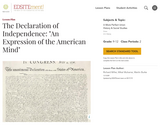
This lesson plan looks at the major ideas in the Declaration of Independence, their origins, the Americans' key grievances against the King and Parliament, their assertion of sovereignty, and the Declaration's process of revision.
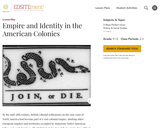
In this lesson students will examine the various visions of three active agents in the creation and management of Great Britain's empire in North America: British colonial leaders and administrators, North American British colonists, and Native Americans.
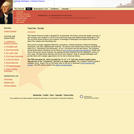
This Teacher Resource Guide is designed for incorporation into history and social studies curricula. It will introduce your students to some of the events and issues that shaped George Washington’s life. The activities should enhance your students’ knowledge of Washington and expand their horizons about this complex and interesting man.
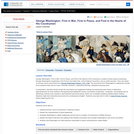
Students use Library of Congress primary sources to examine George Washington's leadership in the French and Indian War, at the Federal Convention, and as chief executive.
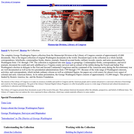
This site includes letters, diaries, financial accounts, military records, and other writings from Washington's youth and service as a surveyor and colonel, as delegate to the Continental Congress, as commander during the Revolutionary War, and as president (1789-97). His many interests and correspondents make these papers are a rich source for almost every aspect of early American history.

This inquiry by Amy Johnson, Longview Public Schools, is based on the C3 Framework inquiry arc. The students will highlight the two primary sources then reflect. They will then do the Open Mind activity illustrating both points of view they learned from the primary sources, develop a three-event timeline and create a newspaper front page describing “What really happened March 5, 1770.”

This inquiry by Joshua Parker, North Thurston Public Schools, is based on the C3 Framework's inquiry arc. The inquiry takes students through a consideration of what the duties of citizenship are. Students consider current controversies about behavior during the national anthem, historical reasons behind revolutionary and loyalist perspectives during the revolutionary era, and by applying learning to answer how loyalty and opposition play a part in actions of engaged citizens.

This inquiry by Amy Johnson, Longview Public Schools, is based on the C3 Framework inquiry arc. Students will look at multiple points of view on an assigned Intolerable Act. After researching primary sources, student will create a newspaper using BEST evidence from their sources that answers the question, "Why would this event the colonists to revolt?"
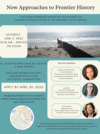
This course looks at the “big picture” of United States history. This course explores the ways in which Americans created their highly original society and culture, the stunning geographical changes that marked the early decades of our new nation, documents that reveal the evolution of key American concepts as well as the many controversies that characterized the second half of US history. One of the goals of this course is for students to come to understand the practice of historical thinking: a form of "reading" the past that you can also apply to any number of other aspects of your college work.
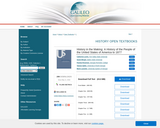
This textbook examines U.S. History from before European Contact through Reconstruction, while focusing on the people and their history. Prior to its publication, History in the Making underwent a rigorous double blind peer review, a process that involved over thirty scholars who reviewed the materially carefully, objectively, and candidly in order to ensure not only its scholarly integrity but also its high standard of quality. This book provides a strong emphasis on critical thinking about US History by providing several key features in each chapter. Learning Objectives at the beginning of each chapter help students to understand what they will learn in each chapter. Before You Move On sections at the end of each main section are designed to encourage students to reflect on important concepts and test their knowledge as they read. In addition, each chapter includes Critical Thinking Exercises that ask the student to deeply explore chapter content, Key Terms, and a Chronology of events.

This course explores fundamental questions about the causes and nature of revolutions by looking at how people overthrow their rulers and establish new governments. Considers a set of major political transformations throughout the world and across centuries to understand the meaning of revolution and evaluate its impact. Examines how revolutionaries have attempted to establish their ideals and realize their goals. Asks whether radical upheavals require bloodshed, violence, or even terror. Seeks to explain why some revolutions succeed and others fail. Materials include the writings of revolutionaries, declarations and constitutions, music, films, art, novels, memoirs, and newspapers.
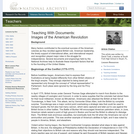
This lesson focuses on the American Revolution, which encouraged the founding fathers' desire to create a government that would, as stated in the Preamble, insure domestic tranquility and provide for the common defense. This lesson correlates to the National History Standards and the National Standards for Civics and Social Sciences.
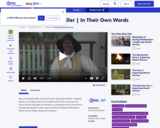
Ben, an enslaved miller at Mount Vernon, discusses freedom. In a reenactment of him thinking aloud, he considers what his life might be like if he runs away from Mount Vernon and gains his freedom as compared to his current life as George Washington's miller.
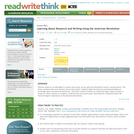
Students across the board will get a kick out of researching a historical figure from the American Revolution to create an acrostic poem.
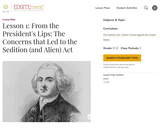
What conditions provided the impetus for the Sedition Act? Partisan animosity was strong during Adams's presidency. The first two political parties in the U.S. were in their infancy"”the Federalists, to which the majority of members of Congress belonged, and the Democratic-Republicans, led by former vice-president Thomas Jefferson and four-term Congressman James Madison, who had left the House in 1796.

Lacking any organized army before 1775 (aside from local colonial militias), the Continental Congress had to assemble a more or less improvised fighting force that would be expected to take on the army of the world's largest empire. This lesson will trace events in the North from 1775 to 1778. By looking at documents of the time, and using an interactive map, students will see how an army was created and understand the challenges that Washington and his men faced during this critical early stage of the war.
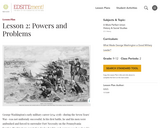
Students examine Washington's ability to handle a wide range of problems during his time as Commander-in-Chief.
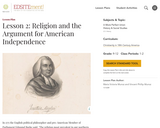
Using primary documents, this lesson aims to introduce students to how the American revolutionaries employed religion in their arguments for independence.
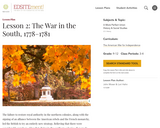
The failure to restore royal authority in the northern colonies, along with the signing of an alliance between the American rebels and the French monarchy, led the British to try an entirely new strategy in the southern colonies. This lesson will examine military operations during the second, or southern, phase of the American Revolution.